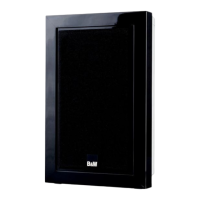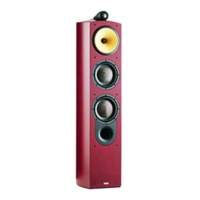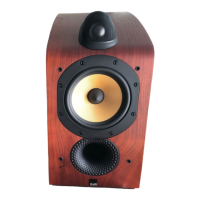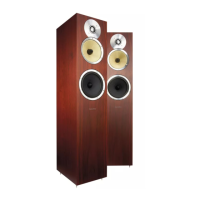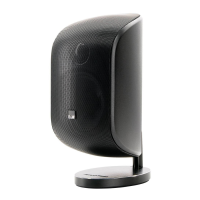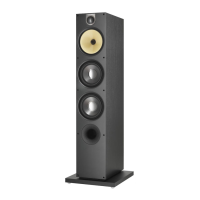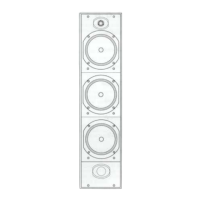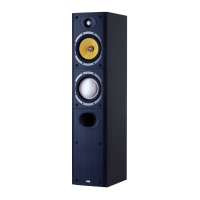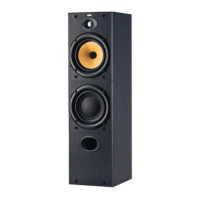Exponential line loading is used for all four
drive units, primarily to achieve freedom from
resonance and reflection, but also for the
damping effect on the fundamental resonance
in the low frequencies.
The two dome units are tightly coupled to
their respective wave guides via a hollow pole
magnet which causes minimal discontinuity to
the advancing wave front.
A hollow pole magnet is also to be found
behind the lower mid diaphragm supported by a
chassis which itself forms the first 50mm of the
wave guide. The tube to which this is attached is
shaped to smooth the transition from the chassis.
The distinctive natural appearance of Nautilus
is derived from the best compromise of folding
a tapered tube to save space whilst maintaining
the highest curvature-to-width ratio. Traditionally,
folded pipes have involved many 180° bends
which have serious frequency dependent
transmission properties.
Enclosure
Each drive unit has been developed to
operate as a piston within its intended
frequency band, with two octaves between
the upper roll-off and the first sign of break-
up modes. Extensive use of aluminium in
the diaphragms makes this possible. All
voice coils are wound on polyimide formers
to eliminate eddy-current losses, which are
particularly serious at high frequencies.
A 9.5kg (21lbs) magnet with a 100mm
(4in) voice coil acts as the massive motor of
the 300mm (12in) bass unit. This, when used
in the exponential line enclosure, results in
a high-pass behaviour so over-damped that
the traditional second-order characteristic
is replaced by two distinct first-order slopes
and no stored energy.
A 250 micron one-piece aluminium cone/
centre dome ensures coherent motion to
beyond 1.5kHz. From 220Hz to 880Hz,
a 100mm flat-fronted unit is employed to
prevent the gentle cavity resonance found
in conventional cone units at around 2kHz
interfering with the output from the upper
midrange unit. A rare earth magnet assembly
with hollow pole is used to minimise the
obstruction to the rear radiation from
the diaphragm.
Two domed units of anodised aluminium
of similar construction, 50mm and 25mm
in diameter, handle the 880Hz-3.5kHz and
3.5kHz-25kHz ranges respectively. All drive
units are completely mounted on silicone
rubber O-rings to decouple them from
the cabinet.
Drive units Crossover
The division of the signal into the four required
bandwidths is accomplished in the Nautilus
Active Crossover via totally nonresonant
circuitry. Both inputs and outputs offer
single and balanced operation, the latter
being particularly useful in noisy electrical
environments, although a slight subjective
improvement has been observed when
using balanced signal interconnections at
every stage.
With suitable pre- and power amplifiers,
one unit is required for each loudspeaker
and should be sited close to the power
amplifiers. A power supply connection for
each crossover is required.
10mm thick Glass Reinforced Plastic (GRP) has
been used for the exterior surface which, when
coupled with the doubly curved shape, results
in an extremely stiff enclosure. The inner turns
of the spiral are bounded by a foam filled GRP
which braces the opposite faces of the snail in
a manner similar to the Matrix type enclosure
perfected by B&W.
The external form of the Nautilus has been
achieved using a blend of hand-built forming
and advanced CAD technology borrowed from
the automotive industry. This enables B&W to
maintain mathematical accuracy of the wave
guide and to produce the final mould tool to
submillimetric accuracy.
The high gloss surface finish is the result
of using a two-part acrylic paint with a deep
lacquer coat for lustre and durability. A 50kg
block of polished terrazzo type material supports
the complete mollusc.
Important: your dealer must
check that the serial number
located at the rear of each
crossover unit matches that
of the loudspeaker – and that
the stated voltage is correct
for your mains supply.

